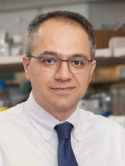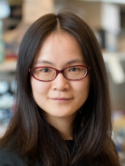Inhibition of NR2F2 restores hormone therapy response to endocrine refractory breast cancers Journal Article
| Authors: | Cai, Y.; Zhao, P.; Wu, F.; Zhao, H.; Shao, H.; Marra, A.; Patel, P.; O’Connell, E.; Fink, E.; Miele, M. M.; Li, Z.; De Stanchina, E.; Cocco, E.; Razavi, P.; Toska, E.; Fanning, S. W.; Xu, G.; Sablina, A. A.; Scaltriti, M.; Chandarlapaty, S. |
| Article Title: | Inhibition of NR2F2 restores hormone therapy response to endocrine refractory breast cancers |
| Abstract: | Endocrine resistance is frequently encountered in estrogen receptor–positive (ER+) breast cancer, often because of somatic mutations such as neurofibromin 1 (NF1) loss. The mechanisms by which ER-directed proliferation is lost in such cases are unknown, limiting the potential use of additional endocrine treatments. Here, we performed CRISPR-Cas9 knockout (KO) screens and found that nuclear receptor subfamily 2 group F member 2 (NR2F2), an orphan nuclear receptor, was essential for NF1 loss–induced endocrine resistance. Induction of NR2F2 was observed in ER+ cell line models and patient samples and occurred via activation of the mitogen-activated protein kinase (MAPK) pathway upon NF1 loss or other MAPK pathway genetic alterations. Mechanistically, increased NR2F2 orchestrated a repressed ER transcriptional program by repartitioning the ER cistrome, altering the balance of its associated transcriptional coregulators, and modifying global chromatin accessibility. Accordingly, genetic depletion or pharmacologic inhibition of NR2F2 restored sensitivity to hormone therapies in multiple models, including ER+ cell lines, patient-derived xenografts, and patient-derived organoid-based xenografts harboring diverse endocrine-resistance mechanisms such as NF1, AT-rich interactive domain-containing protein 1A (ARID1A), phoshatase and tensin homolog (PTEN) loss, or Kirsten rat sarcoma virus (KRAS) overexpression. Together, these findings underscore NR2F2 as a critical modulator of the hormone response pathway and suggest its inhibition as a promising strategy to overcome endocrine resistance in breast cancer. Copyright © 2025 The Authors, some rights reserved. |
| Keywords: | controlled study; treatment response; unclassified drug; human cell; genetics; nonhuman; sensitivity analysis; cell proliferation; mouse; animal; metabolism; animals; mice; animal tissue; cell viability; apoptosis; breast cancer; tumor volume; animal experiment; animal model; transcription factor; drug effect; drug resistance; pathology; drug resistance, neoplasm; cell line, tumor; breast neoplasms; cancer hormone therapy; gene expression regulation; gene expression regulation, neoplastic; genetic transfection; xenograft; breast tumor; tumor cell line; western blotting; phosphatidylinositol 3,4,5 trisphosphate 3 phosphatase; neurofibromin; neurofibromin 1; receptors, estrogen; real time polymerase chain reaction; molecular biology; estrogen receptor; drug therapy; mapk signaling; humans; human; female; article; rna sequencing; cell viability assay; differential gene expression; crispr cas system; crispr-cas systems; mcf-7 cell line; t-47d cell line; cama-1 cell line; multiomics; coup transcription factor ii; nuclear receptor subfamily 2 group f member 2; chicken ovalbumin upstream promoter transcription factor 2; nr2f2 protein, human; efm-19 cell line; endocrine refractory breast cancer; zr-75-1 cell line |
| Journal Title: | Science Translational Medicine |
| Volume: | 17 |
| Issue: | 801 |
| ISSN: | 1946-6234 |
| Publisher: | American Association for the Advancement of Science |
| Date Published: | 2025-06-04 |
| Start Page: | eadk7786 |
| Language: | English |
| DOI: | 10.1126/scitranslmed.adk7786 |
| PUBMED: | 40465692 |
| PROVIDER: | scopus |
| DOI/URL: | |
| Notes: | Article -- MSK Cancer Center Support Grant (P30 CA008748) acknowledged in PDF -- MSK corresponding author is Sarat Chandarlapaty -- Source: Scopus |
Altmetric
Citation Impact
BMJ Impact Analytics
MSK Authors
Related MSK Work














